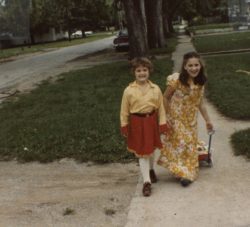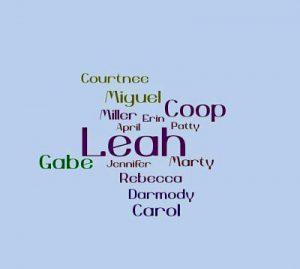Susan Hunter's Blog, page 5
January 17, 2019
Readers Want to Know
[image error]One of the things I like most about writing is hearing from readers. Quite often they say nice things, which is very pleasant. Sometimes they point out errors–a missing word or a typo–which is less pleasant, but still welcome, because I want the books to be as smooth to read as possible. Occasionally they ask questions about the characters and settings in the stories.
Recently a reader asked how I came up with the name of the town where the characters in my Leah Nash Mysteries live: Himmel, Wisconsin. The inspiration actually came from my immigrant grandmother, Susannah Andrews. She spoke English to my six siblings and me most of the time. But when we had driven her to distraction with our antics, she would shout in German “Mein Gott im Himmel!” [My God in Heaven]. It was the signal that we’d pushed just a little too far and repercussions were about to happen. So, the name of my fictional town, in one way, is a bit of an homage to my grandmother. But the choice of name was also intended to be a little more layered.
Himmel, with its shrinking population, abandoned stores and declining economic base, seems pretty far from heaven to Leah Nash, the main character in the series when she returns home. But the more she learns about herself and what matters most to her, the closer the name becomes to describing how she feels about her imperfect, struggling hometown and its inhabitants.
Another frequent question is whether or not Himmel is meant to be my own small town. It isn’t. For one thing, it’s a bit larger, for another, there’s a lot more homicide happening. I will admit though that I sometimes transplant landmarks or variations on them from my hometown to Leah’s.
Readers also ask if the characters in my books are drawn from people in my life. The answer is no, in the strictest sense of the disclaimer you sometimes see in the front pages of books: This is a work of fiction. Any resemblance to actual persons, living or dead, or actual events is purely coincidental.
But that’s not to say that I don’t draw inspiration from people I’ve met or observed—or avoided. I try not to use the name of anyone that I know, to prevent having people in my own life try to match fictional characters with real life counterparts—an exercise I feel has the potential to end badly.
However, it’s inevitable that I’ll sometimes unintentionally create characters whose names belong to actual people. Not long ago, I received a very nice email about just that. The woman who wrote said she’d enjoyed one of my books, but jokingly added that she was a little dismayed because she and the murderer shared a first name.
My email conversation with her gave me the idea of offering readers a chance to be a minor character in the next book in the series. I’m finding it quite fun to weave the winners into the story, and from the response so far, it’s also fun for them to meet “themselves” in a fictional setting.
The contest is only open to members of the Leah Nash Mysteries mailing list. I’ll be inviting entries in late February. Shortly thereafter, two names will be randomly selected to become part of Leah’s story. If you’d like a chance to be a part of the next Leah Nash mystery, but you’re not a member of the mailing list, you can sign up for the list here.
Note: This is an updated version of a post that first ran in 2016.
December 18, 2018
Christmas Boxes
I’m looking forward to Christmas day. We’ll have a loud, laugh-filled gathering of relatives of varying ages at our house. The little kids, having already experienced the thrill of Santa’s largesse at their own homes, will dive excitedly into yet more gifts from indulgent extended family members at ours. And there are few things more fun to watch than an excited, gleeful, and unabashedly materialistic child tearing through the Christmas wrapping to get to the good stuff.
But amid the raucous hubbub, I know that my thoughts will drift away to other Christmases where the presents were less plentiful, but the enthusiasm ran just as high.
Unlike the fortunate offspring in the youngest branches of our family tree today, Christmas gifts for us weren’t the icing on the cake of a well-provided for childhood. They were our once-a-year chance at getting something we really, really, wanted—a pair of ice skates, a doll, a walkie talkie, a paint set, a baseball glove, a robot dinosaur. Those singular “major” gifts were made possible through careful planning and judicious use of a store layaway plan.
The other presents in our small stacks–curated to ensure none of us perceived that one of us had received more than another–were things we really, really needed—typically underwear, socks, pajamas or slippers, all items prone to wearing out before they made it very far on the hand-me-down train. But even those were prized for their no-previous-owner provenance.
Christmas stockings were not an add-on or an after thought for us, as they were for some of our friends. They were part of the main event because our economically challenged but imaginative mother made them so. We each had a handmade stocking adorned with our names in glitter or sequins. Each one was filled with candy, nuts and oranges, but the real fun was in the small “prizes” Mom had hunted down to include.
Our eager fingers dug deep to pull out packs of playing cards, rubber balls, handheld number-slide puzzles, barrettes and ribbons, magnifying glasses, tiny notebooks and new pencils, little plastic snow globes. Anything that caught her fancy that she thought we might have fun with. We pulled each one out, examined it, sometimes stopped to play with it, sometimes held it aloft to show and then negotiate a trade.
Our father enjoyed the show, but it was our mother who directed Christmas morning, and stretched a very small budget into a very big production. We all knew that there were kids who got less than we did, but it took a very long time for us to realize that there were those who got more. And looking back I realize that they really didn’t.
My own children received a much larger and more expensive range of presents that I ever received. It was great fun to watch them shout with happiness when they received not just one, but many things on their wish lists. But I doubt any longed-for gift ever gave them the jolt of joy that shot through me when I opened my favorite childhood Christmas gift.
It wasn’t very promising to look at–a large, battered, cardboard box, not even wrapped. But I can still recall the thrill I felt when I opened the flaps and saw the treasure trove inside. A boxful of books!
I loved the local library, but I longed for books I didn’t have to give back. I had three or four of my own, but I wanted more. A big collection it would take weeks to read through, and to which I could return again and again. The Christmas I was ten years old, my mother found a way to get me my wish. She rescued dozens of old children’s books from a woman who thought no one else would want them. Mom knew she was wrong. The bindings were worn, some pages were brittle and yellowed, and the assortment had a definite musty smell, but I hadn’t yet read any of them. And they were mine to keep.
I received other gifts from my parents over the years that were more “valuable,” but I don’t remember many of them. I’ve never forgotten that box of used books. I hope, you, too, have a special gift from childhood that still evokes happy memories.
Merry Christmas.
December 3, 2018
How Many Shades of Gray?
[image error]
We’re doing a bit of painting at our house and I have had a revelation. I am not color blind, but I am color obtuse. One of my brothers is a professional painter. One of my sisters is a high priestess of home decorating. I said I wanted gray for the living room. I pointed at a color in the paint sample fan deck that my sister provided. (No need to go to the paint store and pick up color cards, she has her own fan deck always at the ready). I thought that pretty much settled things. I soon learned that was not the case.
Though she worded her question politely, it was clear from the surprise in my sister’s voice that my choice was not quite on point.
“Well, that one has quite a bit of green in it. I’ll hold it next to the couch. See? Do you think that’s the color you want?”
“Umm, no?”
In truth, I couldn’t really see the green undertones in that choice, or the blue undertones in the other one, or the purple in another. Holding the sample up to the couch, or the fireplace, or the wall did not help me any either. Something that my sister and my brother could see so clearly was simply not apparent to me. They both patiently tried to educate me on the many shades of gray, but clearly were at a loss when my willingness to learn could not overcome the near complete lack of color sense with which I was born. After several more stabs at picking the color, and responses that gently indicated I was still missing the mark, I randomly hit on one that I liked which passed muster with regard to any ill-advised undertones.
The living room is painted now and looks quite nice. However, the process of picking out the right shade of gray started me thinking about how often we simply cannot see what is so clear to others. It’s not just color palettes to which we respond with the limitations of our particular perceptions.
I am prone to quick judgments and practical answers. Less inclined to nuance and philosophical rumination. “If a tree falls in the forest with no ears to hear does it make a sound?” Yes. Next question. But for some people that is an engrossing metaphysical query, one which they respond to with thoughtful consideration. I’m aware, but often need reminding, that there are different ways of looking at the world, shaped by our ability to perceive the layers that lie beneath the surface of a person, or a situation, or a set of facts.
Thanks to my siblings’ ability to see things that I cannot, I now have a color on the walls that—as they predicted—makes the white woodwork “pop” and picks up subtle hues in the fireplace tile. And I have a reminder that in life and in decorating, what lies beneath is as important as what’s on the surface—even if I can’t see it without help. Still, though, the question remains. How can there possibly be so many shades of gray paint?
[image error]
November 8, 2018
Close Encounters of the Grocery Kind

Be afraid. Be very afraid.
As a work-at-home writer blessed with an extra-supportive spouse, I live a relatively sheltered life far from the crowded aisles and winding check-out lines of the local supermarket. Because grocery shopping is one of my least favorite things, Gary usually handles that task. It’s not only because he likes to be helpful, which he does, but also because he thrives on contact with as many people as possible during the day. I do not.
I confine my grocery shopping ventures to those occasions when he is not available or is not feeling well. Which was the situation on a recent Sunday morning. It was quite early, and I thought that I’d be able to slip in and out quickly to get the few things on my list. That was not to be.
I found the fruits and vegetables I needed, I picked up several things that I did not need, and I got in some daily steps trekking back and forth between the two ends of the store which each held something I was in search of. I crossed everything off my list and headed to the checkout lanes.
You might think that as a card-carrying introvert, I would prefer the self-checkout choice. On one level you would be right. I do like being able to glide quietly through the purchasing process and be on my way. However, experience has taught me that if I have individual fruits or vegetables that will need keying in and/or weighing, something untoward will happen at the register.
Invariably a much more public, chaotic and time-consuming event occurs than would have, had I left the checking out to the professionals. So, I usually choose to stand in a pleasant stupor as someone with quicker fingers and better hand/eye coordination than I have whizzes through my items and bags them, and my only responsibility is to present payment.
I did not have that option on the Sunday morning in question. Not only was there no cashier on duty in any of the regular lines, but every self-checkout register was also in use. And almost everyone in line had full carts. I felt a short-lived surge of happiness when I spied a woman who was in the final stages of making her payment. I scurried in behind her, only to realize that she was not paying, she was staring in puzzlement at the screen and holding in her hand what looked to be coupons that were not processing correctly. I noticed then the red light flashing and her husband trying to flag down a store clerk.
I pulled out of line and spotted a register with only one woman checking out, and her cart was almost empty. However, it turned out that she preferred to run a few things through the register, then pause to bag them. And she was a meticulous bagger of items. She considered each gravely before determining which of her bags should hold it. The minutes ticked by and I was rapidly approaching my maximum tolerance for shopping. Impatient, I pulled out of line and prowled up and down the rows, trying to gauge the best place to jump in. Finally, I settled in behind a man who had a lot of groceries but appeared to be as eager as me to get the job done and get out.
By now my twenty-minute trip to the store had already stretched to fifty minutes. When my turn at the register came, I shot forward. Immediately I began thrusting the bar-coded items at the screen and sending them hurtling down the belt. The faster things progressed, the more my spirits lifted. I was almost done. Then came the dreaded produce. I grabbed the zucchini with determination. I scanned it in. I put it on the scale for weighing. I placed it on the belt. The machine announced an unexpected item on the belt. I took it off. I put it back. The message continued. The red light began to flash overhead, announcing to the world that I stood at the register of shame.
A clerk arrived. She fixed it. She left. I tried my next item, a red pepper. I scanned it. I weighed it. I put it on the belt. The unexpected item on the belt message returned. I touched a few things on the screen, shifted the pepper on and off the belt, glanced apologetically at the growing line-up behind me, but again the red light overhead flashed. The clerk returned. Trying to learn from my mistakes, I asked where I had gone wrong. She listed the proper check-out steps. I told her that’s what I’d done. She looked at me with weary skepticism, fixed the issue and left.
I keyed in the last item—an onion. I weighed it, put it on the belt and when a negative message didn’t pop up immediately, I hastily slid my credit card into the processor, removed it when it buzzed and prepared for escape. But instead of my receipt, a new message appeared, informing me that I had committed a serious error. The red light went off again.
My clerk—we had been together long enough that I had begun to think of her as “my” clerk—was at my side almost as soon as the red bat signal flashed. Her expression plainly said that she was disappointed in me. By using my card—which I’d like to add, the card reader had eagerly accepted, until it turned on me—before the produce problem was addressed, I had caused a more difficult issue to resolve than usual.
She got a slip to print, but she noted that the single onion appeared to have cost $3.49. The price for three pounds of onions was $1.99. Obviously, my lone onion did not weigh in at more than five pounds. But, because of the invisible line I’d crossed, her options to help me were limited. She could cancel out the order, and I could start over—clearly, neither she nor I wanted that. Or I could go back to produce and pick up additional onions.
I wanted only a quick escape. I assured her that I didn’t care how much the onion cost. I was happy to pay 3.49 if it would free me from my Groundhog Day checkout experience. I quickly shoved my purchases into a bag, gently pulled the receipt from her hand, thanked her and left with my overpriced onion. She was taken aback by my casual disregard for the excess onion cost. But to me, freedom has always been priceless.
October 29, 2018
Pulling Back the Curtain

It’s all on you, kid.
Four years ago when I finished writing the first book in the Leah Nash Mysteries series, Dangerous Habits, I decided to publish it as an independent “indie” author, rather than with a traditional publishing house. OK, wait a minute. That makes it sound like I had a bidding war for my book going on between major publishers but intrepid soul that I am, I struck out on my own. That’s not exactly how it happened.
I already had some experience with the world of traditional publishing. I had tried to place a nonfiction manuscript with a publishing house several years earlier. That experience taught me a lot about the long and arduous journey an author goes through between typing “The End” and actually seeing a book in print. Before anything else can happen, you have to find an agent. That can take weeks and often months of querying to connect with someone who says she’d like to read your manuscript. Then it takes additional waiting time of weeks to months for her to get back with you, usually to say, “Thanks, but no thanks.”
But, if the happy day comes when you actually find an agent who wants to represent you, the query process starts all over again, only this time your agent is trying to find a publisher who wants to offer you a contract for your book. That again is a months-long process, which quite often ends not with a contract, but with your agent (if she’s very nice) regretfully telling you that it’s not your book’s fault, but it’s just not a good fit in the current publishing market. By then you’ve spent the better part of a year, or more, trying to get your book published. You can elect to start all over again with a different agent, or you can put your manuscript in the bottom drawer of your desk and move on to the next writing adventure, battered but unbowed.
Which brings me back to the point at which I finished writing my first fiction manuscript and decided to publish it myself as an indie author. I talked to a writer I knew who had taken that route, I read some articles, learned that I could publish both an ebook and a paperback version through Amazon and I thought, “How hard can this be?”
I’m here to tell you, a lot harder than you might think. What you gain in speed to publication from indie publishing is balanced by what you lose in terms of the services a traditional publisher provides, e.g., editing, proofing, formatting, book cover design, and marketing. In other words, it’s all on you, kid. Plus setting up a website, building and learning to manage a mailing list, and way too many technical details to get into here.
There was a huge learning curve for my first book, and I made many, many, many mistakes that cost me most of the profits and a significant portion of my sanity during my first two years as an indie author. And, sadly, because I am a slow learner, and there are always new things to learn about indie publishing, I continue to make mistakes as I stumble my way through my series. Still, the control, the freedom, and the immediacy indie publishing offers offsets—most of the time—the absence of the turnkey services traditional publishing provides. I still haven’t found the magic formula for marketing a series. Despite having a large family of supportive siblings and children who push the books as much as they can, and a husband who has never had a conversation with a friend—or a stranger—wherein he does not try to sell them a book, their reach is still fairly limited.
I’m in the home stretch for book 5, Dangerous Flaws. Editing and revisions are done, manuscript is with the proofer, with only corrections, formatting and a final print proof review to come. But instead of the vacation from all things writing that I like to take between books—wherein I immerse myself in other people’s books—I’ll be spending at least part of the time on the business end of writing. In this case, trying to master the art of building a marketing strategy—which apparently involves advertising plans, social media ads, costs per impression, click-through-rates, return on investment and Lord knows what else. And somewhere in there, developing the plot for book 6. Wish me luck.
September 28, 2018
I finished!
 A short, but happy post. At long last, I have finished the draft of Book 5 in the Leah Nash series, Dangerous Flaws. For a variety of reasons, which I will not bore you with here (those who wish to be bored may contact me via email and I will be happy to oblige), I fell behind on my writing schedule. Like, way beyond the-dog-ate- my-homework behind.
A short, but happy post. At long last, I have finished the draft of Book 5 in the Leah Nash series, Dangerous Flaws. For a variety of reasons, which I will not bore you with here (those who wish to be bored may contact me via email and I will be happy to oblige), I fell behind on my writing schedule. Like, way beyond the-dog-ate- my-homework behind.
Which I hate to do. To make up for it, I have abandoned normal things like cooking, cleaning, and washing my hair for a greater percentage of the last few weeks than I am comfortable specifying. I have not read for pleasure, nor written a blog post, nor kept up with my friends and family the way that I like to.
But today, I typed “The End,” on the last page of my 300+ page manuscript. In my heart of hearts, I know it’s not really the end. Editing and proofing and formatting and many other things must happen over the coming weeks before publication, I know. But for this brief, shining moment, I’m going to say I’m done. At least until tomorrow.
Now, I am going to drink a glass of wine, eat something I shouldn’t, and sleep the sleep of the just. Good night.
August 13, 2018
Though nothing can bring back the hour …
 I saw a lemonade stand last week. Just a little kid with a sign and a table. It wasn’t remarkable, except for the fact that I realized I haven’t seen one in years. Which got me thinking that it’s been a long while since I drove by a park in the afternoon, and saw it filled with children, and I can’t remember the last time I saw kids dressed up in cast-off adult clothes, playing a game of make believe, or marching down the street in a neighborhood parade.
I saw a lemonade stand last week. Just a little kid with a sign and a table. It wasn’t remarkable, except for the fact that I realized I haven’t seen one in years. Which got me thinking that it’s been a long while since I drove by a park in the afternoon, and saw it filled with children, and I can’t remember the last time I saw kids dressed up in cast-off adult clothes, playing a game of make believe, or marching down the street in a neighborhood parade.
Times change, and so do customs. Carefully orchestrated play dates and scheduled activities have taken the place of pick up games of baseball or bike rides that ranged all over town. The internet and its unlimited horizons may have eclipsed the joy of exploring neighborhood boundaries. Parents made wary by the 24/7 cable news focus on abductions and other dangers now keep children more tightly tethered than my siblings and I were, or than my own kids were when they were little.
This is not to say that ‘back in the day it’ was better, but it was definitely different. When I was a child, we left the house in the morning, came back for lunch, left again until dinner, then we were outside until the street lights came on. The only thing that brought us back home betimes was grievous personal injury — a serious scrape needing a bandaid and a little sympathy, or maybe a broken bone. Though there were surprisingly few of those, given the many trees climbed, bike miles ridden and forbidden bridges crossed.
And there was endless time on hot summer days to do nothing but lie on a blanket in the shade of a tree and watch the clouds passing by, while the leaves whispered softly overhead. And though my own children had more scheduled activities than I did as a child, they still spent most of their free time with neighborhood friends in self-generated play — producing “radio” shows with a tape recorder, organizing dog circuses with our long suffering pet Carrie, sailing on a pirate ship (that also doubled as our front porch) with their friends.
But in this worrisome world, it may well be a luxury with too high a price for parents to allow their offspring the freedom to ramble. And families that need two incomes must juggle jobs and day care with organized ways to give their children play time. I get it, but still …
I miss the sound of joyful whoops and indignant howls as games are won and lost in neighborhood backyards on long summer nights, and the sight of kids playing dress-up in cast-off formal wear, and the taste of watery lemonade on a hot summer afternoon, handed to me with a chubby, grubby hand, and the happy smile of a young entrepreneur.
At the heart of the matter, I suppose, my longing for the return of free and unfettered play isn’t really for the kids’ loss. It’s for mine.


This post first ran in August 2015.
July 19, 2018
I’m Gonna Need A Bigger Book
 Once upon a time in a galaxy far, far away, a fellow reporter and I broke a story that was centered in our small town, but which had tentacles that stretched across the country. It was a very complex tale that was told over several days with multiple related articles appearing in each day’s paper.
Once upon a time in a galaxy far, far away, a fellow reporter and I broke a story that was centered in our small town, but which had tentacles that stretched across the country. It was a very complex tale that was told over several days with multiple related articles appearing in each day’s paper.
After it ran, the story was picked up by papers around the country, and a number of reporters from multiple papers called for background and source information as they did their own follow-ups. There was nothing unusual about that until I took a call and the voice on the other end of the line said, “Hi, this is Wally Turner from the New York Times.”
The New York Times was then the height to which young journalists aspired. That a Times reporter was calling me for help on a story was thrilling beyond measure. Sadly, instead of coolly taking it in stride, as though major daily newspaper reporters called me every week to ask for my insights and help, I went full Aunt Barbara on him.
My much-loved Aunt Barbara was a woman who could not pass on information without a large helping of extraneous material. If you asked her where she got her shoes, her answer usually included the name, medical history, and genealogy of everyone she saw at the store where she purchased them. And she knew a lot of people. Eventually, you would get the information you sought, but not without a lot of side trips down roads you hadn’t intended to travel. A variation on that is what the Times reporter got from me.
I was so excited to be sought out by the Times that I couldn’t stop the outpouring of details that rushed out of me as I tried to ensure that he really, truly, fully, understood the complexities of the story and that he had everything he needed. Finally, he reined me in gently and said that he only had sixteen column inches to fill and more than enough background. “It looks to me like I’ll be trying to stuff a ten-pound story into a five-pound sack,” he said.
I thought of that recently as I hit the halfway point of the fifth book in the Leah Nash series. Usually, I’m pretty elated to reach that spot, because the second half of writing a book always goes faster than the first for me. But I’m not so happy, because I realized that although I’m halfway through the word count I targeted, I’m only a third of the way through the plot. Oh-oh.
Either I’m going to have to cut a lot out in the editing process, or I’m gonna need a bigger book.
June 28, 2018
A Matter of Characters
 I try to roll with the feedback if a reviewer doesn’t like some aspect of a book I’ve written—or even doesn’t like any aspects of any book I’ve written. To each his own, right? One reader’s can’t-put-down book can be another’s can’t-get-into-it.
I try to roll with the feedback if a reviewer doesn’t like some aspect of a book I’ve written—or even doesn’t like any aspects of any book I’ve written. To each his own, right? One reader’s can’t-put-down book can be another’s can’t-get-into-it.
However, I can feel quite protective when someone criticizes not the book as a whole, but a character in particular. That is especially true when the character under fire is my lead, Leah Nash. I will be the first to admit that Leah is not always even-tempered, or wise, or mature, or forgiving. She is prone to acting impulsively. She has a quick tongue and doesn’t always filter what she says. And she’s pretty bossy and hates to be wrong. Hmm, as I write this I can see where the critics are coming from. And yet … She is generous of heart, loyal to a fault, quick-thinking, self-aware, fearless and funny. I enjoy writing her because she is a sometimes contradictory combination of light and dark.
But I’ve had to accept that some people don’t see her the way I do. A parallel for me in real life is when a friend informs me that she can’t stand a person we both know, but I find that person delightful. Some readers respond to Leah as I do, and some don’t.
Because the series is set, for the most part, in the small town of Himmel, Wisconsin, a recurring cast of characters pops in and out of the stories as foils and friends of Leah. Sometimes readers take a shine to a minor character and want to see more of her or him. The request I get most often is for “more Miguel, please.” Miguel Santos is a young reporter at the Himmel Times Weekly. He’s extroverted, optimistic, tolerant, good-looking and gay (in both the old-school and the modern sense of the word). No one has a bad time when Miguel is around. He’s a perfect counter-point to Leah’s more cynical outlook on life. And I’m happy to spend more time with him, myself.
On the other hand, Courtnee Fensterman, the receptionist at the Himmel Times is a polarizing figure among my readers. She’s a pretty, vapid, self-centered receptionist in her early 20s, who is described this way:
Self-confident without any basis, incompetent without any awareness, unencumbered by any sense of responsibility, she is perpetually aggrieved and slightly perplexed by job duties that pull her away from Tweeting, Tindering, and [Snap Chatting].
Readers either love her for her blissful state of self-absorption or hate her for it. I understand why some people urge me to kill her off. But despite her ditzy, self-involved ways, I do have a soft spot for her as one of my offspring. And she’s useful at times in furthering the plot.
One of the nice things about a series is that you can allow your characters to grow and change and that can be reflected, in part, by the way they interact with other characters. For example, Charlie Ross, a detective with the sheriff’s department, started out in a small role as an adversary of Leah’s. Eventually, he became a friend. I leave it to readers to decide whether Charlie changed, or Leah did, or if they both grew a little in understanding.
To say that Leah has trust issues is putting it mildly, and given her life experiences, it’s not surprising. However, she has no reservations about trusting her best friend, a man she’s known since they were both 12 years old, growing up in Himmel. David Cooper, known to Leah and almost everyone else as Coop, is a lieutenant in the Himmel Police Department. They both enjoy the easy comfort and tolerance that long-term friendship can bring. I get frequent calls for their friendship to morph into romance, though to date both have chosen other romantic interests. And to be honest, I’m not sure if they will ever be more than very good friends. Then again, I’m not sure that they won’t be.
I think that the characters a writer creates—even the not very nice ones—have a claim on the author’s affections. But, as is the case with parents, writers must send their characters out into the world to face whatever fate awaits them. Some readers will love them, some will hate them. But the worst response to a character isn’t hate, it’s indifference. Because attention, good or bad, is what all characters—and maybe all writers—crave.
Note: This first appeared as a guest post on The Book Diva Reads blog.
June 14, 2018
My Day at the Office
 When I worked in a traditional job in a traditional office, it was common practice during a push to meet a deadline to retreat to cubicles or offices, close doors, send calls to voicemail, and focus entirely on getting the project done.
When I worked in a traditional job in a traditional office, it was common practice during a push to meet a deadline to retreat to cubicles or offices, close doors, send calls to voicemail, and focus entirely on getting the project done.
I find that harder to do in my home office because the other person who lives in the house cannot easily be ignored by the mere closing of a door. Gary is a very active person for whom to think, is to do. He is in and out of the house at least half a dozen times a day: to have coffee, to attend a meeting, to go to the hardware store, to visit a friend, to talk to a neighbor, to organize a meeting, to go to the post office, to stop at the library. If an idea pops into his head, he acts on it. And he gets an amazing amount of things done in a day.
I, on the other hand, spend quite a lot of time thinking before doing. But once started I like to work straight through for long periods, focused and undisturbed. Gary likes to share regular updates on his progress, and he usually meets this need as he interacts with people on his rounds. Except on the occasional day when he decides to spend time working on projects at home.
This is what my day at the office is like then:
9 a.m. Gary looks at a two-year-old tax return that he has come across “organizing” his files. He calls to me to come downstairs to his desk and look at the item that is disturbing him. I look. It does not disturb me. I go back to my desk.
9:30 a.m. Gary sees something odd on the surface of the river. He goes out to explore. I do not see it because my blinds are closed. He asks me to video what he’s seeing. I go outside to shoot the video. I go back to my desk.
10 a.m. Gary calls me downstairs to hold the tape measurer for him. I do. I do not ask why, or what he is doing. That might land me in a project I want nothing to do with.
10:30 a.m. Gary comes to my office to tell me we’re out of toner for the printer. I suggest he might like to run to the store to buy some. He does.
11 a.m. Gary returns from the store. He comes to my office to tell me about a person I don’t know, who is doing something I don’t care about. Then he gives me some flowers. Now I find it harder to order him out of my office, but I do anyway.
11:15 a.m. Gary calls up to me from his desk downstairs. He asks me if it’s going to rain tomorrow. I tell him I don’t know.
11:25 a.m. Gary comes to my office to tell me that yes, it is going to rain tomorrow.
11:26 a.m. I close my door. Loudly.
11:40 a.m. Gary taps softly on my door and whispers—as though the act of speaking softly cancels out the disturbance—asking if I know where his meeting file is. I do not.
11:45 a.m. I have hung a Do Not Disturb sign on the doorknob. I can hear Gary walk down the hall toward my office, then footsteps retreating after he sees the sign. Then it is quiet. Then I hear him in the kitchen faux whistling an unrecognizable tune—making half humming, half flutey-sounding noises. Then he stops. Then he starts. Then he stops. A few minutes pass. Then he starts again.
I start laughing. Because, well, Gary. I take the sign off the door and catch up on my email instead of writing the next chapter. Tomorrow is another day.
Note: This post first appeared in March 2016. It’s here again both because I’m hard at work on the fifth Leah Nash Mystery and I’m behind schedule, and because the content is still true. 



